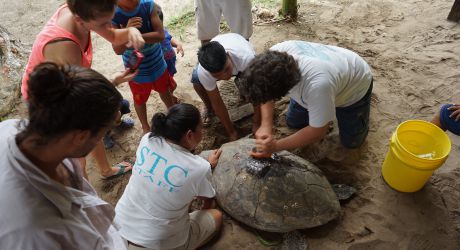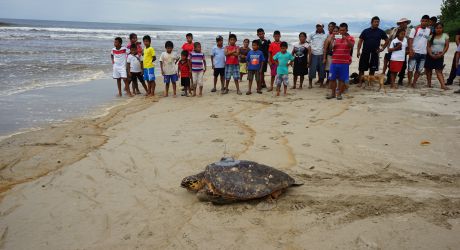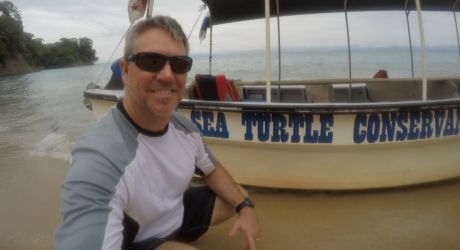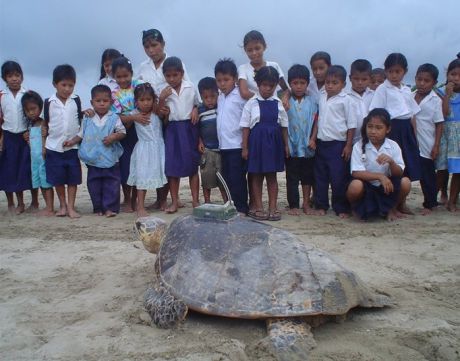Project Background
This project was carried out during the 2017 leatherback and hawksbill turtle nesting season at Chiriquí Beach, Panama. Chiriquí Beach, located east of Bocas del Toro, Panama, on the Atlantic Coast of Central America, is a 24 km beach that hosts globally-important nesting populations of both leatherback and hawksbill sea turtles. For decades the hawksbills nesting at Chiriquí were killed by the tons for their shells, which fed international demand for “tortoise shell.” Meanwhile, both leatherbacks and hawksbills face ongoing pressure from illegal poaching and predation by feral dogs.
The aim of this project was to implement a seasonal program of nest monitoring, collaboration with indigenous community members and nest protection in order to stop the killing and predation of sea turtles and their nests at Chiriquí Beach – and also to improve hatchling survival by reducing threats such as predation by feral dogs.

Project Overview
STC carried out a rigorous research and conservation program in partnership with the indigenous Ngobe-Bugle Indian community at Rio Cana and Rio Chiriquí (located on both ends of Chiriquí Beach). This work was supported greatly by the funding provided by the Footprints Network.
Through the project, Sea Turtle Conservancy collected vital survivorship and nesting trend data about the sea turtle populations. In addition, our staff, in coordination with the local community, carried out a rigorous nest protection and anti-poaching program to increase hatchling survival.
As part of this program, we carried out community education efforts to increase control of dogs, and we covered vulnerable nests with wire mesh in order to deter predation. Members of the indigenous community were trained how to monitor and protect nests, and at least 20 community members were employed full-time on the project – providing a sustainable source of income to a good number of local families.

Project Objectives & Activities
The four objectives of this project were:
- To sustain a long-term research and conservation program at Chiriquí Beach, a globally-important nesting site for both leatherback and hawksbill sea turtles.
- To reduce illegal poaching of nesting females and egg clutches in order to increase productivity of leatherbacks and other species nesting at Soropta.
- To reduce egg and hatchling mortality caused by predation from dogs through caging and direct protection of nests, along with a sustained education program in the neighbouring community
- Actively involve local community members in the project and implement environmental education programs in nearby communities to build local awareness and stewardship.
Each of these objectives was carried out successfully during the course of the project. In particular, the nest protection program was successful at reducing the level of poaching and decreasing the number of nests impacted by predators—particularly dogs. The problem still remains, but the number of nests disturbed by dogs was reduced significantly this year.
In order to track the survival rate of nests at Chiriquí Beach, community members trained by STC biologists carried out careful monitoring of nests. The results give us a scientifically accurate assessment of the overall level of poaching and predation at Chiriquí Beach. Compared with the total amount of nesting so far this year (3,146 leatherback nests & 1,199 hawksbill nests), the level of poaching was quite low. Predation is a more significant problem, but the number is decreasing each year that STC works on this beach.

Tracking & Education
STC also conducted its satellite-tracking education program that involved putting transmitters on three leatherback turtles and one hawksbill turtle at Chiriquí Beach. All of these turtles are being tracked online at www.tourdeturtles.org and are yielding important information about the migratory movements of sea turtles. Most importantly, many members of the indigenous community came out to watch the release of the turtles – a celebration that helped reinforce the need to protect and cherish this important animal that nests on beaches under the jurisdiction of the indigenous community.
What Next?
The work at Chiriquí Beach represents a long-term commitment by STC to monitor and protect this critical nesting beach in partnership with the local community. We foresee the program continuing for at least another decade or more.
Project Background
Chiriqui Beach, located east of Bocas del Toro, Panama, on the Atlantic Coast of Central America, is a 20-mile-long beach that hosts up to 7,000 endangered leatherback nests per year--making it one of the most densely nested leatherback beaches in the Caribbean. Chiriqui also hosts up to 2,000 hawksbill nests. For decades the hawksbills nesting at Chiriqui were killed by the tons for their shells, which fed international demand for “tortoise shell.” Meanwhile, both leatherbacks and hawksbills face ongoing pressure from illegal poaching and predation by ferrel dogs.
STC, which conducts long-term monitoring and protection of nesting beaches, launched a research and protection program at Soropta in 2003. An on-site biologist coordinates the program with the direct assistance of a team of local indigenous community members who have been trained in all the necessary techniques to monitor turtle nesting and protect nests. Having community members directly involved also aids in STC’s outreach program to raise awareness and to deter poaching. Since the program was launched, poaching has decreased significantly, but the problem still remains.
In addition, the dog predation problem is ongoing and requires constant oversight to protect nests from bands of roaming dogs from the community. It’s imperative for STC to maintain a permanent presence at Chiriqui Beach to protect nesting leatherbacks, hawksbills and their eggs.

Project Objectives
The aim of this project is to stop the killing and predation of endangered leatherback and hawksbill sea turtles and the poaching of their nests at Chiriqui Beach, Panama. This globally-important nesting beach, though protected within an indigenous zone, is so remote that Panamanian authorities are unable to enforce protection measures. The nearest human population is a nearby indigenous community of Ngobe-Bugle Indians, where the illegal poaching originates. There also is a problem with predation by dogs from the village.
Sea Turtle Conservancy is implementing a proven strategy of hiring and training local community members to assist with turtle protection. Predation is being addressed by caging nests and working with the community to control the dog population. Through direct protection of nests, combined with ongoing community outreach to explain the ecological and economic value of turtles (for ecotourism); STC aims to reduce survival threats and give this population of leatherbacks and hawksbills a chance to recover.
Project objectives can be summarised as:
- Sustain a long-term research and conservation program at Chiriqui Beach, a globally-important nesting site for both leatherback and hawksbill sea turtles.
- Reduce illegal poaching of nesting females and egg clutches in order to increase productivity of leatherbacks and other species nesting at Soropta.
- Reduce egg and hatchling mortality caused by predation from dogs through caging and direct protection of nests, along with a sustained education program in the neighboring community.
- Actively involve local community members in the project and implement environmental education programs in nearby communities to build local awareness and stewardship.

Intended Outcomes
The project’s long-term goal is to eliminate all poaching at this site and fully recover the leatherback hawksbill population nesting at Chiriqui. This program is modelled after a long-term project carried out by STC at Tortuguero, Costa, which has shown amazing results, with reduced poaching and a rapidly-growing nesting population, so we are optimistic that similar results can be achieved at Chiriqui. The Tortuguero program has helped fully recover a renowned green turtle nesting colony and is a model for sea turtle conservation around the world. The Chiriqui Program will mimic STC’s proven tactics to achieve similar successful outcomes.
Program Partners and Community Involvement
The main partners in this project are the indigenous Ngöbe-Buglé community members—a semi-autonomous native Indian community in this region of Panama. The majority of staff members are from a local community, just inland of the nesting beach. All of the people conducting the monitoring and conservation activities at Soropta Beach are members of the indigenous community, except for a single field biologist who coordinates the program. The coordinator is Panamanian, though not a member of the indigenous community. STC also partners with the Smithsonian Tropical Research Institute, which maintains a large research station in Bocas del Toro. Last year, STC conducted a park guard training program at the STRI station designed to give Panamanian authorities more information and experience in how to recognize and prevent illegal turtle poaching.

How does this project fit into a larger strategy?
For nearly 60 years, STC has conducted sea turtle research and protection on the Caribbean coast of Central America. This project fits well with the organization’s long-term strategies and goals for sea turtle recovery. In addition to the long-term program at Tortuguero, Costa Rica, STC now conducts long-term monitoring and protection program on the Caribbean coast of Panama – with the nesting site at Chiriqui Beach being the most important among them.
It is estimated that the 4th largest population of leatherbacks in the world nests at Chiriqui, alongside one of the largest-remaining colonies of hawksbills in the Atlantic. Reducing causes of sea turtle mortality at this beach will help sustain and recover both species.